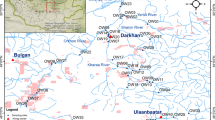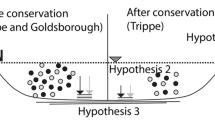Abstract
To elucidate relationships between land cover and water quality along the central California coast, we collected monthly samples from 14 coastal waterway outlets representing various degrees of human development. Sites were distributed between three salinity categories, freshwater, estuarine, and marine, to better understand land cover-water quality relationships across a range of coastal aquatic ecosystems. Samples were analyzed for fecal indicator bacteria (FIB), dissolved nutrients, stable nitrogen isotopes in particulate organic matter, and chlorophylla (chla). Sediment samples from 11 sites were analyzed for the concentration of the anthropogenic organic contaminant perfluorooctane sulfonate and its precursors (ΣPFOS). While the data indicated impairment by nutrient, microbial, and organic contaminants at both agricultural and urban sites, the percentage of agricultural land cover was the most robust indicator of impairment, showing significant correlations (p<0.05) to FIB, nutrient, chla, and ΣPFOS levels. FIB densities were strongly influenced by salinity and were highest at sites dominated by agriculture and urbanization. Nutrient levels and chla correlated to both agricultural and urban land use metrics as well. Positive correlations among FIB, nutrients, chla, and ΣPFOS suggest a synergy between microbial, nutrient, and organic pollution. The results emphasize the importance of land management in protecting coastal water bodies and human health, and identify nutrient, microbial, and organic pollution as prevalent problems in coastal California water bodies.
Similar content being viewed by others
Literature Cited
Atlas, E. L., S. W. Hager, L. I. Gordon, and P. K. Park. 1971. A practical manual for the use of the Technicon Auto AnalyzerTM in seawater nutrient analysis (revised). Oregon State University, Department of Oceanography, Technical Report 215, Reference 71-22. Corvallis, Oregon.
Balarajan, R., V. C. Raleigh, P. Yuen, D. Wheeler, D. Machin, andR. Cartwright. 1991. health risks associated with bathing in sea water.British Medical Journal 303:1444–1445.
Bartram, J. andG. Rees. 2000. Monitoring bathing waters: A practical guide to the design and implementation of assessments and monitoring programmes, E and FN Spon, London, England.
Bordalo, A. A., R. Onrassami, andC. Dechsakulwatana. 2002. Survival of fecal indicator bacteria in tropical estuarine waters (Bangpakong Rover, Thailand).Journal of Applied Microbiology 93:864–871.
Chang, C. C. Y., C. Kendali, S. R. Silva, W. A. Battaglin, andD. H. Campbell. 2002. Nitrate stable isotopes: Tools for determining nitrate sources among different land uses in the Mississippi River Basin.Canadian Journal of Fisheries and Aquatic Science 59:1874–1885.
Clement, C., S. B. Bricker, and D. E. Pirhalla. 2001. Eutrophic Conditions in Estuarine Waters.In National Oceanic and Atmospheric Administration's State of the Coast Report. Silver Spring, Maryland. http://state-of-coast.noaa.gov/bulletins/html/eut_18/eut.html
Cohen, J. E., C. Small, A. Mellinger, J. Gallup, andJ. Sachs. 1997. Estimates of coastal population.Science 278:1209–1213.
Costanzo, S. D., M. J. O'Donohue, andW. C. Dennison. 2003. Assessing the seasonal influence of sewage and agricultural nutrient inputs into a subtropical river estuary.Estuaries 26:857–865.
Costanzo, S. D., M. J. O'Donohue, W. C. Dennison, N. R. Loneragan, andM. Thomas. 2001. A new approach for detecting and mapping sewage impacts.Marine Pollution Bulletin 42:149–156.
Edwards, D. R., M. S. Coyne, T. C. Daniel, P. F. Vendrell, J. F. Murdoch, andP. A. Moore. 1997. Indicator bacteria concentrations of two northwest Arkansas streams in relation to flow and season.Transactions of the American Society of Agricultural Engineers 40:103–109.
Edwards, D. R., B. T. Larson, andT. T. Lim. 2000. Runoff nutrient and fecal coliform content from cattle manure application to fescue plots.Journal of the American Water Resources Association 36:711–721.
Giesy, J. P. andK. Kannan. 2002. Perfluorochemical surfactants in the environment.Environmental Science and Technology 36:146a-152a.
Higgins, C. P., J. A. Field, C. S. Criddle, andR. G. Luthy. 2005. Quantitative determination of perfluorochemicals in sediments and domestic sludge.Environmental Science and Technology 39: 3946–3956.
Kendall, C. 1998. Tracing nitrogen sources and cycling in catchements, p. 519–576.In C. Kendall and J. J. McDonnell (eds.), Isotope Tracers in Catchment Hydrology. Elsevier Science, Amsterdam, The Netherlands.
Kendall, C., S. R. Silva, andV. J. Kelly. 2001. Carbon and nitrogen isotopic compositions of particulate organic matter in four large river systems across the United States.Hydrological Processes 15:1301–1346.
Key, B. D., R. D. Howell, andC. S. Criddle. 1998. Defluorination of organofluorine sulfur compounds byPseudomonas sp. strain D2.Environmental Science and Technology 32:2283–2287.
Kirschner, A. K. T., T. C. Zechmeister, G. G. Kavka, C. Beiwl, A. Herzig, R. L. Mach, andA. H. Farnleitner. 2004. Integral strategy for evaluation of fecal indicator performance in bird-influence saline inland waters.Applied and Environmental Microbiology 70:7396–7403.
Mallin, M. A., K. E. Williams, E. C. Esham, andR. P. Lowe. 2000. Effect of human development on bacteriological water quality in coastal watersheds.Ecological Applications 10:1047–1056.
Molvaer, J., J. Knutzen, J. Magnusson, B. Rygg, J. Skei, and J. Sorensen. 1997. Environmental quality classifications in fjords and coastal areas. Satens Forurensningstilsyn TA-1467. Oslo, Norway.
Osborne, L. L. andM. J. Wiley. 1988. Empirical relationships between land use/cover and stream water quality in an agricultural watershed.Journal of Environmental Management 26: 9–27.
Pennington, J. T. andF. P. Chavez. 2000. Seasonal fluctuations of temperature, salinity, nitrate, chlorophyll and primary production at station H3/M1 over 1989–1996 in Monterey Bay, California.Deep-Sea Research Part II 47:947–973.
Roth, N. E., M. T. Southerland, D. E. Srebel, andA. Brindley. 1998. Landscape model of cumulative impacts: Phase I report. Maryland Department of Natural Resources, Columbia, Maryland.
Rowe, H. D., R. B. Dunbar, D. A. Mucciarone, G. O. Seltzer, P. A. Baker, andS. Fritz. 2002. Insolation, moisture balance and climate change on the South American altiplano since the last glacial maximum.Climatic Change 52:175–199.
Ryding, S. O. andW. Rast. 1989. Man and the biosphere: The control of eutrophication of lakes and reservoirs, Volume 1. UNESCO, Parthenon Publication Group, Park Ridge, New Jersey.
Smith, V. H. 1998. Cultural eutrophication of inland, estuarine and coastal waters, p. 7–49.In M. L. Pace and P. M. Groffman (eds.), Successes, Limitations and Frontiers in Ecosystem Science. Springer-Verlag, New York.
Tian, Y. Q., P. Gong, J. D. Radke, andJ. Scarborough. 2002. Spatial and temporal modeling of microbial contaminants on grazing farmlands.Journal of Environmental Quality 31:860–869.
U.S. Environmental Protection Agency (USEPA). 2003. Ambient Water Quality Criteria for Dissolved Oxygen, Water Clarity and Chlorophylla for the Chesapeake Bay and its Tidal Tributaries. USEPA, Chesapeake Bay Program Office, Annapolis, Maryland.
Vølstad, J. H., N. E. Roth, G. Mercurio, M. T. Southerland, andD. E. Strebel. 2003. Using environmental stressor information to predict the ecological status of Maryland non-tidal streams as measured by biological indicators.Environmental Monitoring and Assessment 84:219–242.
Wernick, B. G., K. E. Cook, andH. Schreier. 1998. Land use and stream water nitrate-N dynamics in an urban-rural fringe watershed.Journal of the American Water Resources Association 34: 639–650.
Wilkerson, F. P., R. C. Dugdale, A. Marchi, andC. A. Collins. 2002. Hydrography, nutrients and chlorophyll during El Niño and La Niña 1997–99 winters in the Gulf of the Farallones, California.Progress in Oceanography 54:293–310.
Author information
Authors and Affiliations
Corresponding author
Rights and permissions
About this article
Cite this article
Handler, N.B., Paytan, A., Higgins, C.P. et al. Human development is linked to multiple water body impairments along the California coast. Estuaries and Coasts: J ERF 29, 860–870 (2006). https://doi.org/10.1007/BF02786537
Received:
Revised:
Accepted:
Issue Date:
DOI: https://doi.org/10.1007/BF02786537




